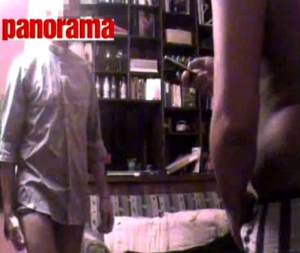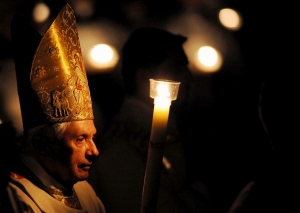Newsweek
July 27, 2010
http://www.newsweek.com/2010/07/27/the-vatican-s-gay-priests.html
 |
| A gay priest, wearing his clerical collar, a shirt, and little else, was caught on video in an Italian newspaper’s investigation. |
For residents of Rome, the sight of courting priests is hardly an anomaly. But a recent expose is rocking the Catholic Church.
In the basement dining room of Le Mani In Pasta, a trattoria in central Rome, a young, glossy-eyed couple stare at each other across a table for two. They smile and blush over a private joke. There is no handholding or kissing, but they are clearly more than friends, even though they are both wearing dark shirts and the telltale white clerical collar.
For residents of Rome, the sight of courting priests is hardly an anomaly. The phenomenon is a well-known secret here, and one that was largely ignored until last weekend, when the Italian weekly magazine Panorama published a shocking expose called “Le Notti Brave Dei Preti Gay,” or “Good Nights Out for Gay Priests.” Investigative journalist Carmelo Abbate spent 20 days undercover posing as the boyfriend of a man who ran in gay clerical circles, secretly videotaping the sexual escapades of three Rome-based priests. Abbate caught the priests on hidden camera dirty dancing at private parties and engaging in sex acts with male escorts on church property. He also caught them emerging from dark bedrooms in time to celebrate mass. In one postcoital scene, “Father Carlo” parades around seminaked, wearing only his clerical vestments. Abbate’s “date” even had sex with one of the priests to corroborate the story. “This is not about homosexuality,” Abbate, who is not gay, told NEWSWEEK. “This is about private vices and public virtues. This is about serious hypocrisy in the Catholic Church.”
The expose has touched a nerve within the Catholic community in Rome, but Abbate doesn’t believe that it will have any effect, especially given the Vatican’s other sex scandal. Yet unlike the pedophile-priest crisis, which has so far reached scores of dioceses in the United States and Europe, the gay-priest problem is—so far—an issue just for the Rome diocese on the Vatican’s home turf. Most priests in Rome have some affiliation with the Vatican, and Abbate says one of the priests caught on tape also gave mass in St. Peter’s Basilica. The Vatican says that the offending priests from Abbate’s story will be sought out and stripped of their collars. Cardinal Agostino Vallini, head of the Rome diocese, is in charge of purging the offending clerics, and he has called on all gay priests who cannot respect the basic tenet of celibacy to get out of the priesthood. “Priests who are living a double life have not understood what the Catholic priesthood is and should not have become priests,” he said in a statement responding to the Panorama expose. “Consistency demands that they be discovered. We do not wish them ill, but we cannot accept that because of their behavior the honor of all the other priests is dragged through the mud.”
Vallini may have the right idea when it comes to punishing those who break priestly laws, but the church as a whole seems to find it difficult to differentiate its sex scandals—and to determine what role celibacy plays in either situation. In April, Vatican secretary of state Cardinal Tarcisio Bertone famously blamed gay priests for the pedophilia problem during a press conference in Santiago, Chile. “Many psychologists and psychiatrists have demonstrated that there is no relationship between celibacy and pedophilia,” he said. “But many others have demonstrated, I have been told recently, that there is a relation between homosexuality and pedophilia. That is true. That is the problem.”
 |
| ALBERTO PIZZOLI |
The Vatican backpedaled at the time of Bertone’s comments, admitting that 90 percent of sex-abuse cases do involve priests and adolescent boys, but changing the verbiage from “homosexual” to “same-sex attraction” when talking about the cases. But Abbate’s tell-all expose that launched the current scandal has nothing to do with the priest-to-young-parishioner relationship. In fact, the two sex scandals are vastly different. The gay priest problem is about celibacy, church law, and hypocrisy. The pedophile problem is about child abuse, criminal behavior, and abuses of power.
Victims’ rights advocates, however, have noticed that the Vatican seems more focused on sexual orientation than sexual deviance, and they are furious. While clergymen spent years covering up rumors of child-sex abuse and protecting each other, they’re calling instantly for the ouster of gay priests. “Priests who are committing sex crimes against children and bishops who enable and conceal the crimes are the ones leading double lives,” says Barbara Blaine, head of Survivors Network for those Abused by Priests. “They are the ones who should resign.”
Through the years, a number of directives have been issued addressing priest sexuality. A 1961 Vatican document signed by Pope John XXIII clearly outlines church policy. “Advancement to religious vows and ordination should be barred to those who are afflicted with evil tendencies to homosexuality or pederasty, since for them the common life and the priestly ministry would constitute serious dangers.”
In 2002, the church softened its stance slightly under Pope John Paul II, whose spokesman said the church should become “less welcoming” to gays in priesthood. “That does not imply a final judgment on people with homosexuality,” he said, refraining from calling homosexuality an “evil tendency” like under the earlier papacy. “But you cannot be in this field.” In 2003, before Cardinal Joseph Ratzinger became pope, he described homosexuality as a “troubling moral and social phenomenon” affecting the church. And when he became pope in 2005, he focused on gay priests with a five-page “instruction” document calling homosexuality “objectively disordered” but allowed that men could enter the seminary after a period of abstinence. “Men who practice homosexuality, present deep-seated homosexual tendencies or support the so-called ‘gay culture’ cannot be admitted to seminaries,” Ratzinger, as Pope Benedict XVI, wrote. “The only exception would be for those with a ‘transitory problem’ that had been overcome for at least three years.”
But requirements like those are impossible to enforce, and they are plainly ignored. In Rome’s medieval quarter of Trastevere not far from Le Mani In Pasta, the International Ecclesiastic Seminary attracts men from all over the world who want to study for the priesthood in the heart of Rome. A professor there, speaking on the condition of anonymity to protect his job, says the vast majority of the young men who come to study are sexually active gay men who quickly become part of the lively gay culture in Rome. Not all the priests are gay or practicing, he concedes, but in recent years he says he has noticed that most new students are young men with a certain sexual slant, and he fears that the institution has a reputation for attracting only gay seminarians.
The exact number of gay priests worldwide is unknown. A study conducted in 2000 by Father Donald Cozzens for his book The Changing Face of Priesthood suggests that as many as 60 percent of all American Catholic priests were gay, but those numbers varied greatly depending on geographical location. “At issue at the beginning of the 21st century is the growing perception that the priesthood is, or is becoming, a gay profession,” Cozzens wrote in his book. “Heterosexual seminarians are made uncomfortable by the number of gays around them.”
Celibacy is not optional in the priesthood, so sexual orientation should be a moot point. But Abbate believes that in Rome, the heart of Catholicism, gay priests feel a certain liberty that straight priests do not. He says he found many openly gay priests on Facebook and other social-networking sites, including a popular Roman Catholic online community called Venerabilis. Abbate also discovered through his covert research that male escorts and transsexual prostitutes in Rome rely on priests as regular customers. Last March, a member of the Vatican choir admitted to police that he arranged male escorts for papal assistants, including Angelo Balducci, a high-ranking member of Gentlemen of his Holiness, a fraternal order whose members assist the pope. Abbate did not find the same code of conduct for heterosexual priests. “You just don’t see heterosexual priests out in the same way,” he says. “Gay priests live freely here; they just do as they please.”
The Catholic church and gay-rights groups quickly pointed out that Abbate’s piece was full of offensive stereotypes, right down to the cover shot of a man’s hands with pink nail polish clutching a rosary. Panorama is owned by Prime Minister Silvio Berlusconi’s media conglomerate, and the Vatican hinted that the attack was political in nature. Berlusconi’s own sex scandals and ongoing divorce have been widely criticized by the Vatican. Abbate shrugs off the insinuation, pointing to the countless other exposes he has done that have been just as hard on Berlusconi’s government. “This is about uncovering a story of extreme hypocrisy,” Abbate told NEWSWEEK. “It’s not a government agenda against the church.”
Pope Benedict XVI is at his summer retreat in Castelgondolfo outside Rome, and, for now, the Vatican is keeping quiet and leaving it up the diocese of Rome to clean up the latest problem. But weeding out noncelibate priests likely won’t make this problem go away, according to religious commentator Bryan Cones, who writes for the popular U.S. Catholic blog. “On this matter, the church’s real problem is the closet,” he says. “I must agree with the Vicar of Rome that it would be helpful if gay priests would come out—so we could thank them for their faithful service, especially as they have been unjustly tarred with ‘causing’ sex abuse. Unfortunately, our church leadership at this time is not creating the kind of open and safe space that would allow for such honesty.”
Any original material on these pages is copyright © BishopAccountability.org 2004. Reproduce freely with attribution.